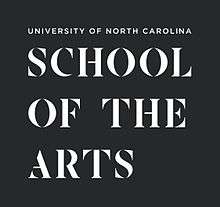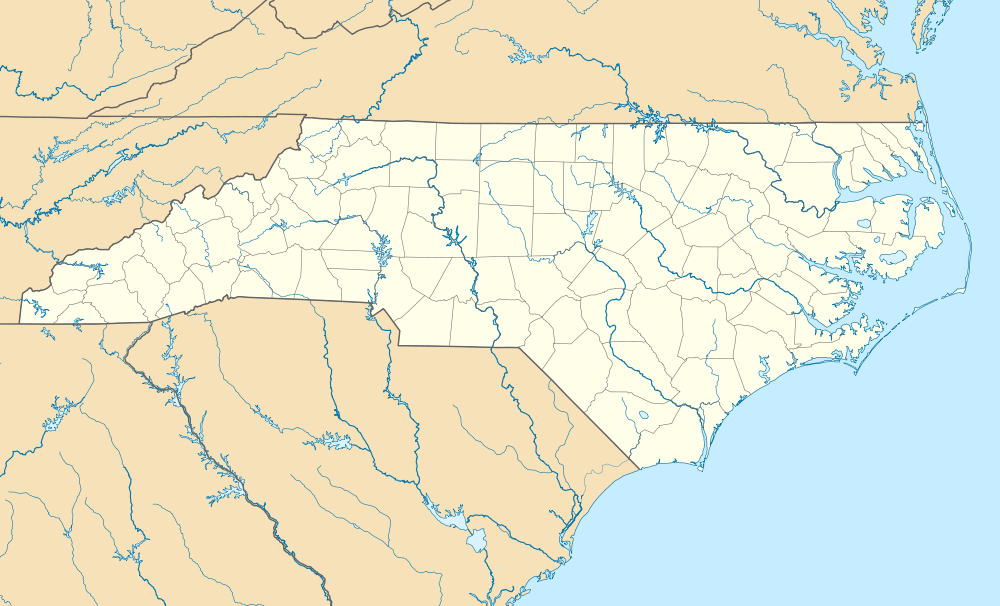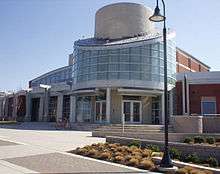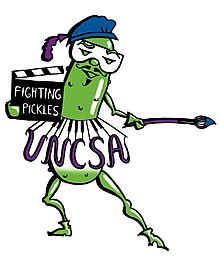University of North Carolina School of the Arts
The University of North Carolina School of the Arts (UNCSA) is a public art school in Winston-Salem, North Carolina. It grants high school, undergraduate, and graduate degrees. Founded in 1963 as the North Carolina School of the Arts by then-Governor Terry Sanford, it was the first public arts conservatory in the United States. The school owns and operates the Stevens Center in Downtown Winston-Salem and is accredited by the Southern Association of Colleges and Schools.
 | |
Former names | North Carolina School of the Arts (1963–2008) |
|---|---|
| Type | Public art school |
| Established | 1963 |
Parent institution | UNC System |
| Endowment | $27.7 million |
| Chancellor | Brian Cole |
Academic staff | 186 |
| Students | 1,144 |
| Undergraduates | 739 |
| Postgraduates | 124 |
Other students | 276 (high school) 5 (special) |
| Location | , , United States 36°04′32″N 80°14′11″W |
| Campus | Urban |
| Colors | UNCSA black, white |
| Website | www |
 | |
 Location in North Carolina  University of North Carolina School of the Arts (the United States) | |
The school consists of five professional schools: School of Dance, School of Design & Production (including a HS Visual Arts Program), School of Drama, School of Filmmaking, and School of Music.
History
Founding
The idea of the University of North Carolina School of the Arts was initiated in 1962 by Vittorio Giannini, a leading American Composer and teacher of Composition at Juilliard, Curtis and Manhattan, who approached then-governor Terry Sanford and enlisted the help of author John Ehle and William Sprott Greene, Jr.[1] and Martha Dulin Muilenburg of Charlotte, North Carolina, to support his dream of an arts conservatory. State funds were appropriated, and a North Carolina Conservatory Committee was established. The School of the Arts became a constituent institution of the University of North Carolina in 1972.[2]
In 2008, the institution's board of trustees voted unanimously to change the name of the school from the North Carolina School of the Arts to the "University of North Carolina School of the Arts" to raise its profile.[3] The name change was subsequently approved by the University of North Carolina Board of Governors, North Carolina Senate, North Carolina House of Representatives, and Governor Mike Easley.[4][5]
Leaders
Vittorio Giannini was the School's founder and first President. His vision of arts education shaped UNCSA at its beginning and continues to influence it today. Giannini served as President of the fledgling institution until his death in November 1966. A resolution dated December 3, 1966 by the Board of Trustees and the Governor pays tribute to Giannini as the founder of the School, noting that 'When it was a dream, he sought a home for it and helped bring it into being. When it was an infant institution, he gave it structure and design.' The Pulitzer Prize-winning composer Robert Ward became UNCSA's second president following Giannini's death.
In 1974 Robert Suderburg became UNCSA's third chancellor following Martin Sokoloff, the administrative director, who served as interim chancellor from 1973 to 1974. During his time at UNCSA the Workplace building, containing the Semans Library, was opened on the UNCSA campus, as well as the Stevens Center, previously the Carolina Theatre, in downtown Winston-Salem. The gala opening of the Stevens Center featured the school's symphony orchestra conducted by Leonard Bernstein, with Isaac Stern as soloist and Gregory Peck as the Master of Ceremonies. Attendees included Agnes de Mille, Cliff Robertson, Governor James Hunt, President and Mrs. Gerald Ford and Lady Bird Johnson. The Stevens Center remains UNCSA's largest performance facility.[6]
Jane E. Milley became Chancellor at the School of the Arts in September 1984. In the spring of 1990, Alex C. Ewing was appointed Chancellor. He assumed the position in July 1990, following Philip R. Nelson, former Dean of music at Yale University, who served as Interim Chancellor during the 1989–90 school year. Ewing had been associated with the School since 1985, when he became chairman of the Board of Visitors. In 1988 he established the Lucia Chase Endowed Fellowship for Dance at the School, in memory of his mother, a co-founder and principal dancer with American Ballet Theatre. A man of diverse talents, Ewing almost single-handedly revitalized the Joffrey Ballet during his tenure as general director in the 1960s. As Chancellor, Ewing oversaw the success of the School's $25 million campaign for endowment and scholarships. He also orchestrated a combination of local, state and national support to secure the establishment of NCSA's fifth arts school, the School of Filmmaking, in 1993. Ewing took a special interest in NCSA's campus plan. Other capital projects he spearheaded included a new Sculpture Studio, a new Fitness Center, and the start of the Student Commons renovation. Wade Hobgood, Dean of the College of the Arts at California State University at Long Beach since 1993, was named Chancellor in February 2000, assuming the position on July 1, 2000. A native of Wilson, NC, Hobgood attended East Carolina University, where he earned a Bachelor of Fine Arts and Master of Fine Arts in Communication Arts.
John Mauceri was UNCSA's seventh chancellor.[7] He assumed the position following Gretchen M. Bataille, former Senior Vice President for Academic Affairs of the 16-campus University of North Carolina, who served as Interim Chancellor during the 2005–2006 academic year. Mr. Mauceri earned Bachelor of Science and Master of Philosophy in music theory degrees from Yale University, where he was also a member of the faculty for fifteen years. He is internationally known as a conductor, arranger and music director; he was the first American to hold the post of music director in both British and Italian opera houses. For the last fifteen years he had been the Director of the Hollywood Bowl Orchestra in Los Angeles, California. A distinguished recording artist, he has won Grammy, Tony, Emmy and Drama Desk awards. In addition, he frequently writes articles on opera, musical theater and music for the American cinema. Chancellor Mauceri announced in the Fall of 2012 that he would retire at the conclusion of the 2012–2013 academic year.
Brian Cole is the current interim chancellor of UNCSA, succeeding Lindsey Bierman who served as chancellor from 2014 to 2019.[8]
Campus

The school's campus consists of 77 acres (310,000 m2) in Winston-Salem, near Old Salem.[9] There are eight residence halls – six for college students, two for high school students, an on-campus student apartment complex and an off-campus student apartment complex within walking distance. The school has eleven performance and screening spaces; the ACE Exhibition Complex with three movie theaters, Crawford Recital Hall (with a Fisk Organ), deMille Theatre for dance, Hood Recital Hall, Performance Place with three theatrical spaces, the Stevens Center in downtown Winston-Salem, and Watson Chamber Music Hall. Performance Place is the home of the drama department, the ACE Theatre is the home of the filmmaking department, deMille theatre is the home of the dance department and Watson, Hood and Crawford halls are used by the music department. The Stevens Center is shared.
The school also has a fitness center with an interior basketball court, the Semans Library, the Hanes Student Commons, Workplace (adjacent to the library) which holds Visual Arts Studios as well as Offices and Studios for the School of Dance, Gray Building, which holds high school academics on the third floor and music offices and practice rooms on the first and second floors, a building holding two dance studios, a visual arts sculpting studio, a large design and production complex, a costume, wig and makeup studio, a welcome center, and several buildings for administrative offices and college academics. New studio spaces and a new apartment complex are currently under construction.
Performance opportunities
UNCSA offers many performance opportunities throughout the course of a school year. Dance students have three seasonal performances: Fall dance, Winter dance, and Spring dance. They also perform the Nutcracker every Christmas as well as many other minor performances throughout the school year. Music students have the chance to perform in front of their peers every Wednesday at performance hour, and students are usually in a large ensemble, such as jazz band, orchestra, opera, or wind ensemble. These ensembles each perform several times a year.
The School of Design and Production is responsible for the scenery, costumes, wigs, makeup, lighting, sound, and stage management for all shows produced by the School of Drama, two operas that UNCSA produces each year through the Fletcher Opera Institute, as well as dance performances, although dance costumes are provided partly by the Costume Department and also by the School of Dance's own professional costume shop. The Lighting Department each December presents a showcase entitled "Photona" which combines industry-leading and latest lighting as well as projection equipment.
The Film-making school is host to the ACE Exhibition Complex, where students can display their work and watch others. This complex, along with the Stevens Center, is host to the RiverRun International Film Festival every spring.
All School Musical
Once every four years, UNCSA produces an all-school musical – a massive, extensive, Broadway-style production involving all five arts schools of the conservatory. All students have the opportunity to audition. Past all-school musicals have included Brigadoon, Oklahoma!, Kiss Me Kate Canterbury Tales, and "Guys and Dolls"[10] with the most recent one being Bernstein's Mass. The purpose of the all-school musicals are not only to provide the students with professional experience but also to raise money and awareness for the school. For example, for West Side Story the lead roles and Chancellor John Mauceri traveled to New York to promote the school and the school's revival of the musical.[11] West Side Story was performed at UNCSA's Stevens Center from May 3–13, 2007, and then went on tour to Chicago's Ravinia Festival[12] on June 8, 2007. The production was directed by Dean of Drama Gerald Freedman, the assistant director of the original production, and conducted by UNCSA Chancellor and world renown conductor John Mauceri. It has also been reported that Arthur Laurents changed portions of the dialogue for the UNCSA production.[11] In May 2011, UNCSA presented "Oklahoma!" as an all-school musical.[13]
Notable alumni
Student life
Mascot

Although UNCSA has no officially sanctioned athletic teams, the school has a mascot: The Fighting Pickle.[14] The premiere athletic event from the early 1970s was an annual touch-football game between a UNCSA team versus one from a Wake Forest University fraternity.
The mascot was selected by a contest name the football team in 1972. The original name was simply "The Pickles," along with a slogan, "Sling 'Em By The Warts!" but the mascot eventually became "The Fighting Pickles." In the spring of 2010, UNCSA hosted a competition to choose the new, official "Fighting Pickle" mascot. Design entries and voting was opened to students, alumni, faculty, staff and former faculty and staff. The winner was unveiled on May 21, 2010 in the Student Union's cafe, "The Pickle Jar."[15]
Student organizations
UNCSA has many active student organizations, including, but not limited to, the following:
- SGA (Student Government Association)
- Pride (UNCSA's Gay, Lesbian, and Transgender support organization)
- United States Institute for Theatre Technology (USITT) Student Chapter
- Overly Rambunctious God's Youth (Comedy Improv troupe)
- Artists of Color
- S.G. (UNCSA High School Student Government)
References
- Staff Reporter. "Course Stresses Originality, Blends Ballet, Geometry." Charlotte Observer. Feb, 1966
- Banner, Leslie (1992). A Passionate Preference. Down Home Press. ISBN 1878086014.
- "Frequently Asked Questions about the proposed name change: NCSA to UNCSA". University of North Carolina School of the Arts. Archived from the original on 2008-05-17. Retrieved 2008-06-26.
- "May 9, 2008, Board of Governors Meeting Minutes" (PDF). University of North Carolina Board of Governors. pp. 6–7. Archived from the original (PDF) on July 20, 2011. Retrieved 2008-06-26.
- Robertson, Gary D.; Woodward, Whitney; Robinson; Natasha (2008-06-25). "June 25, 2008, at the North Carolina General Assembly". Associated Press. Retrieved 2008-06-26.
- "Having survived early missteps, today's Stevens Center thrives 25 Entertaining Years". The Winston-Salem Journal. Archived from the original on March 22, 2012. Retrieved 2008-06-30.
- "NCArts.edu: Chancellor Home Page". University of North Carolina School of the Arts. Archived from the original on June 16, 2008. Retrieved 2008-06-30.
- "Southern Living editor elected chancellor at UNC School of the Arts". Archived from the original on 2014-12-25. Retrieved 2014-11-16.
- "Visitor's Center: Fact Sheet". University of North Carolina School of the Arts. Archived from the original on August 7, 2008. Retrieved 2008-06-30.
- "50th Anniversary West Side Story Coming to NCSA and Ravina". Broadwayworld.com. Retrieved 2007-03-06.
- "West Side Story Visits New York City". The Kudzu Gazette. Archived from the original on 2007-10-24. Retrieved 2007-03-12.
- "North Carolina School of the Arts Presents New Production To Celebrate 50th Anniversary of West Side Story". The North Carolina School of the Arts. Archived from the original on 2007-06-16. Retrieved 2007-03-06.
- "News Article". Uncsa.edu. 2011-04-29. Retrieved 2014-08-24.
- "The True Story of How the Pickles Got Their Name - UNCSA". Uncsa.edu. Retrieved 2020-04-17.
- "2010 Pickle Mascot Winner". The University of North Carolina School of the Arts. Archived from the original on 2010-09-06. Retrieved 2010-06-18.
External links
| Wikimedia Commons has media related to University of North Carolina School of the Arts. |
